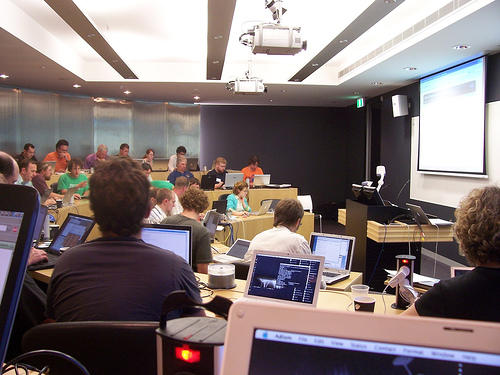Since middle school, I used some sort of technology in the classroom, whether it was for a game we were playing in class, a project, or to complete a homework assignment. Some examples of technology that I used in the classroom were phones, tablets, and laptops. I always enjoyed using technology because I thought it was interesting to learn rather than using an outdated textbook that was 20 years old. However, some professors, like Susan Dynarski at the University of Michigan, are now banning laptops from classes and research seminars. I feel that laptops should not be banned in classrooms because they help students with note-taking, offer more options for writing and editing, and allow disabled students equitable opportunities for learning.
Some may argue that using laptops in the classroom distracts others around them. In an article from the New York Times, “Laptops Are Great. But Not During a Lecture or a Meeting”. The professor, Susan Dynarski says that laptops should be banned in lectures and meetings. She states that” Some students were told to perform small tasks on their laptops unrelated to the lecture, like looking up movie times. As expected, these students retained less of the lecture material. But what is really interesting is that the learning of students seated near the laptop users was also negatively affected” (Dynarski). Based off of this reasoning that laptops are distracting for surrounding students, is a terrible basis to ban laptops altogether. By banning laptops, you don’t take disabled students into consideration. In an article titled “When You Talk About Banning Laptops, You Throw Disabled Students Under the Bus,” the authors Ph.D. Jordynn Jack and Ph.D. Katie Rose Guest Pryal discuss how disabled students are negatively affected by this wave of bans. According to the authors, “Sarah Singer, a graduate student at the University of North Carolina, finds being outed as disabled extremely awkward: ‘I need a laptop to accommodate my arthritic wrists and fingers, and many students have hand/wrist issues that make it difficult to write by hand, too.’ Only allowing students with documented disabilities to use laptops in classrooms makes them stand out even more and appear to receive special treatment. Students are then left to defend themselves since instructors can’t reveal why some students are permitted to have certain accommodations” (Jack). Because of this ban, Sarah feels because she is permitted to use laptops in classrooms, students around her in her class resent her because she’s able to use a laptop. The authors bring another student to share their opinion about how laptops should be used. “Carrie (a pseudonym), an undergraduate student at a large public university, put it this way: “If your class is sufficiently fast-paced and entertaining, I’ll take notes on my computer.” If it’s too slow-paced or poorly planned, she said, “then it is totally your own fault that people are zoning out” (Jack). Students should have the choice to use their laptops whenever they want. The next argument that the authors found wrong about Dynarski’s article is her stating that laptops distract students and those around them who aren’t using laptops. “But this study is meaningless without a second control group of students using non-technological distractors—the distractors that we used in college before we had laptops, or distractors that students are using right now in lecture halls where laptops are banned, such as crossword puzzles, doodling, and (gasp) flirting” (Jack). I find it interesting that Dynarski would include this argument in her article, but it is wrong because there is not enough evidence to support it.
Laptops offer students a range of options for writing, editing, and note-taking. The first reason is it’s a faster way to take notes in class. In an article from seattlepi, “What Are the Benefits of Laptops for Students?”, the author Maria Magher discusses the benefits of students using laptops. According to Magher, note taking is easier on a laptop. Magher states, “When students have laptops, they can type their notes directly into a document. Electronic note-taking is both faster and more flexible. Digital note taking allows students to index and organizes their study material automatically, quickly search for information by keyword and share notes with other students. Digital notes can be stored and backed up, so they are not lost — unlike paper notes — which may become destroyed or lost” (Magher). These are great reasons for using a laptop for someone who has a hard time keeping up with a professor because they talk too fast. Also, note-taking on a computer is great for people when they do take notes and cannot read the notes that they took. A great reason that Magher brings up for laptops to be used in classrooms is there are more options for students to write and edit using a laptop. In the article by Magher, she states that “A project to give students laptops in the classroom in Maine resulted in an increase in student writing achievement, according to The National Writing Project. Eighty percent of students in the project said they would rather use their laptop to do their work and were more likely to edit their work using their laptop” (Magher). Students in the classroom found laptops helpful with their writing and editing.
Banning laptops in classrooms is not the way to go. Such as students found it to be easier to take notes because you can type faster than you can write. Also, laptops are great for helping people improve their writing and editing by using software such as Word. Lastly banning laptops jeopardizes the learning of disabled students.
